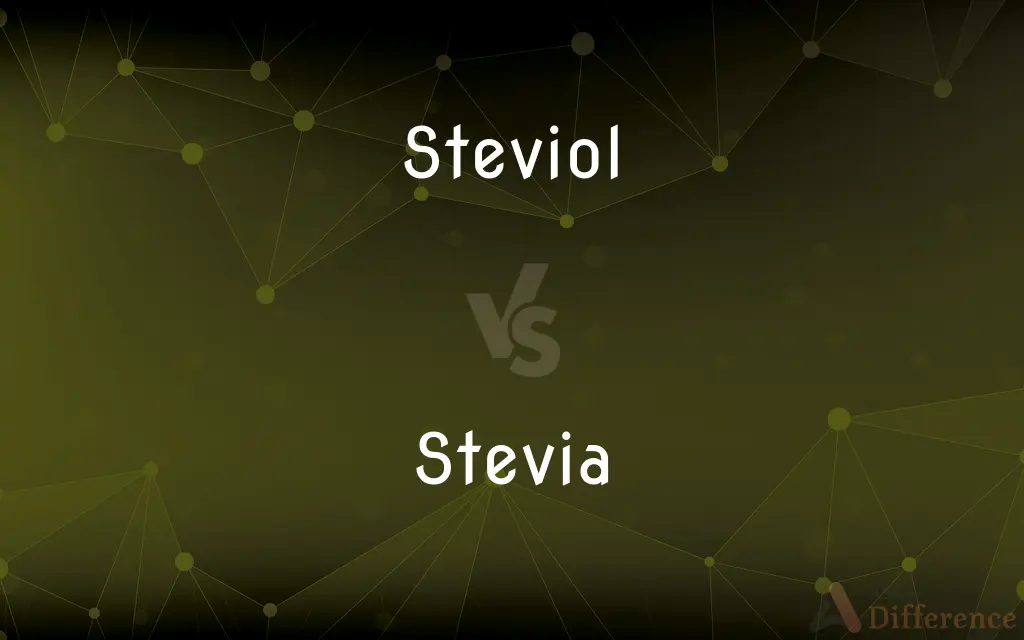Steviol vs. Stevia — What's the Difference?
By Fiza Rafique & Maham Liaqat — Updated on March 18, 2024
Steviol refers to a compound derived from the stevia plant, while Stevia encompasses the whole plant and its extracts used as sweeteners.

Difference Between Steviol and Stevia
Table of Contents
ADVERTISEMENT
Key Differences
Steviol is a specific chemical compound found within the Stevia rebaudiana plant, known for its role in the plant’s sweetening properties. It is a part of the steviol glycoside family, which are the sweet compounds processed and extracted from stevia leaves. Stevia, on the other hand, refers to the entire plant species Stevia rebaudiana Bertoni, which is native to South America and known for its natural sweetness. Stevia as a term is also used to describe the extracts derived from the plant, which are used as non-nutritive sweeteners in foods and beverages.
These glycosides, once ingested, are metabolized in the body to steviol, which is responsible for the sweet taste without adding calories. These extracts are rich in steviol glycosides, including stevioside and rebaudioside A, which are hundreds of times sweeter than sugar but with negligible calorie content.
While steviol is an end product of the metabolism of steviol glycosides and is crucial in understanding the body’s processing of stevia-based sweeteners, stevia encompasses both the raw plant and the processed extracts used globally as sugar substitutes. This distinction highlights the difference between a singular compound and the broader category of products derived from the stevia plant.
In terms of consumption, steviol itself is not directly consumed or used as a sweetener. Instead, it is the steviol glycosides within the stevia extracts that are consumed for their sweetening properties. The safety and usage of these compounds have been extensively studied and approved by various international health and regulatory bodies.
The popularity of stevia in the food and beverage industry is due to its ability to provide a sweet taste without the added calories or effects on sugar levels that come from consuming conventional sugars. This makes it an attractive option for people managing diabetes, obesity, or those simply looking to reduce their sugar intake.
ADVERTISEMENT
Comparison Chart
Definition
A compound resulting from the metabolism of steviol glycosides.
A plant species known for its sweet leaves and the extracts derived from it.
Nature
Chemical compound.
Plant and its extracts.
Use
Not used directly; important for metabolic studies.
Used as a non-nutritive sweetener in foods and beverages.
Source
Produced in the body after consuming stevia extracts.
Stevia rebaudiana plant.
Primary Contribution
Metabolic byproduct of interest in scientific research.
Natural sweetener with no calories, used as a sugar substitute.
Compare with Definitions
Steviol
Relevant in scientific research on sweeteners.
Studies on steviol examine potential health impacts of stevia consumption.
Stevia
The source of steviol glycosides. offering a calorie-free sweetness.
Stevia extract is a popular sugar substitute in diets.
Steviol
A metabolite of steviol glycosides. crucial for understanding stevia's effect on the body.
Research on steviol helps assess the safety of stevia products.
Stevia
Incorporated into various food and beverage products.
Stevia is found in many low-calorie drinks and snacks.
Steviol
Involved in regulatory evaluations of stevia products.
Steviol analysis is part of the regulatory approval process for stevia extracts.
Stevia
Recognized for its benefits in sugar-restricted diets.
Stevia is recommended for managing diabetes and obesity.
Steviol
Not directly consumed but important in health assessments.
Steviol levels are monitored in studies to ensure stevia's safety.
Stevia
A plant used for its natural sweetening properties.
Stevia leaves have been used for centuries as a sweetener.
Steviol
A byproduct of stevia digestion. indicating stevia's breakdown process.
Detecting steviol in the bloodstream confirms the metabolism of stevia.
Stevia
Cultivated globally for its sweet leaves.
Stevia farming has expanded due to the demand for natural sweeteners.
Steviol
Steviol is a diterpene first isolated from the plant Stevia rebaudiana in 1931. Its chemical structure was not fully elucidated until 1960.Steviol occurs in the plant as steviol glycosides, sweet compounds that have found widespread use as sugar substitutes.
Stevia
Any of various extracts derived from the leaves of S. rebaudiana, used as noncaloric sweeteners and flavoring agents.
Steviol
(organic compound) A diterpene derived from stevia.
Stevia
Stevia () is a natural sweetener and sugar substitute derived from the leaves of the plant species Stevia rebaudiana, native to Brazil and Paraguay.The active compounds are steviol glycosides (mainly stevioside and rebaudioside), which have 30 to 150 times the sweetness of sugar, are heat-stable, pH-stable, and not fermentable. The human body does not metabolize the glycosides in stevia, so it contains zero calories, like artificial sweeteners.
Stevia
Any of various American plants of the genus Stevia of the composite family, especially the perennial S. rebaudiana, native to Paraguay, whose leaves contain sweet-tasting glycosides.
Stevia
Any of the sweet herbs of genus Stevia, native to tropical and subtropical regions of South America and western North America.
Stevia
A sweetener, many times sweeter than an equal amount of sugar, extracted from Stevia rebaudiana, that can be substituted for sugar for some purposes.
Stevia
Any plant of the genus Stevia or the closely related genus Piqueria having glutinous foliage and white or purplish flowers; Central and South America
Stevia
Any plant of the genus Piqueria or the closely related genus Stevia
Common Curiosities
Are steviol and stevia the same thing?
No, steviol is a compound produced from stevia extracts, while stevia refers to the plant and its extracts used as sweeteners.
Why is stevia popular as a sweetener?
Stevia is popular because it offers a sweet taste without calories or affecting sugar levels.
Can stevia help with weight management?
Yes, since stevia provides sweetness without calories, it can be a helpful part of a weight management plan.
Can you consume steviol directly?
Steviol is not directly consumed; it's a metabolite of steviol glycosides found in stevia extracts.
What makes stevia sweet?
The sweetness of stevia comes from steviol glycosides, such as stevioside and rebaudioside A, found in its leaves.
What is stevia?
Stevia refers to the Stevia rebaudiana plant and the sweetening extracts obtained from it.
Is stevia safe to use?
Yes, stevia and its extracts have been deemed safe by various health and regulatory organizations worldwide.
What are the health benefits of using stevia?
Benefits include no calorie intake, minimal impact on glucose levels, and suitability for diabetics and those reducing sugar intake.
What is steviol?
Steviol is a chemical compound resulting from the metabolism of steviol glycosides found in the stevia plant.
How is steviol involved in stevia's approval for consumption?
The metabolism and safety of steviol are studied to ensure that stevia extracts are safe for human consumption.
Is steviol found in all stevia products?
Steviol is not present in the products themselves but is a metabolite produced in the body after consuming stevia.
What's the difference in use between steviol and stevia in the food industry?
Stevia is used as a sweetener in the food industry, while steviol's role is primarily in scientific research and safety assessments.
How is stevia used in foods?
Stevia is used as a natural sweetener in beverages, baked goods, and many other low-calorie, sugar-free products.
Does stevia taste like sugar?
Stevia is much sweeter than sugar but can have a slightly different taste profile, which some describe as licorice-like.
Can stevia cause side effects?
For most people, stevia is well-tolerated, though some may experience mild digestive discomfort.
Share Your Discovery

Previous Comparison
Crenellated vs. Crenulated
Next Comparison
Gasket vs. BushingAuthor Spotlight
Written by
Fiza RafiqueFiza Rafique is a skilled content writer at AskDifference.com, where she meticulously refines and enhances written pieces. Drawing from her vast editorial expertise, Fiza ensures clarity, accuracy, and precision in every article. Passionate about language, she continually seeks to elevate the quality of content for readers worldwide.
Co-written by
Maham Liaqat













































